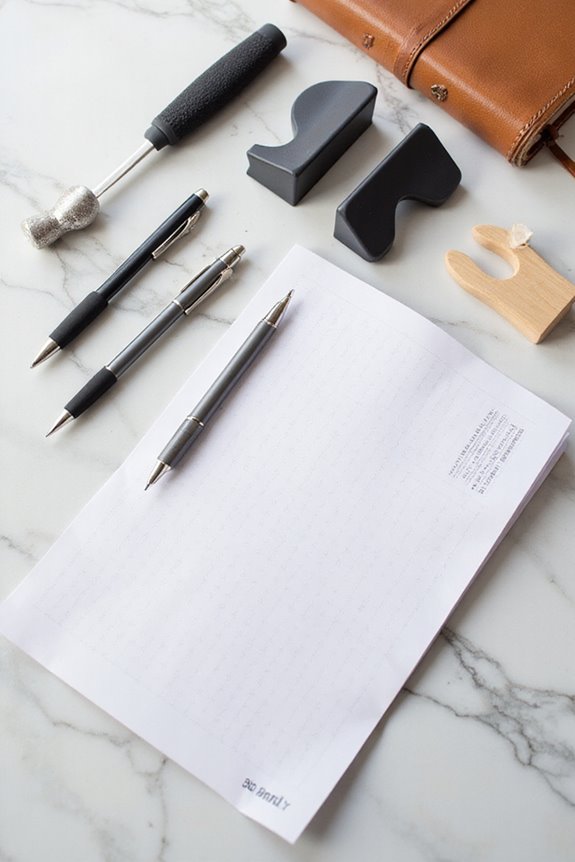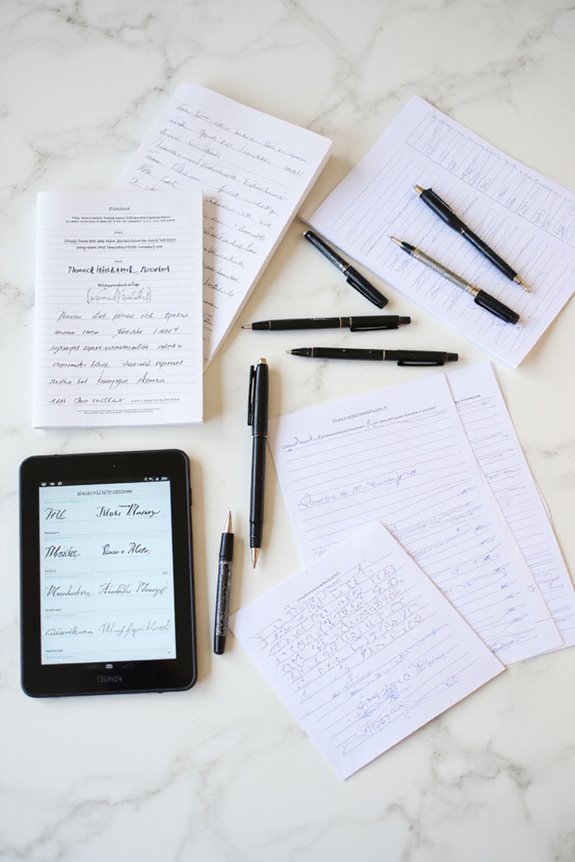To improve handwriting for adults, we can start with adaptive pens that have cushioned grips and ergonomic shapes. These tools help reduce finger fatigue and enhance control. Using specialty paper with clear lines can improve our letter formation and spacing. Engaging in handwriting courses—whether online or through downloadable materials—provides structured practice. Plus, adding fun activities like tracing letters in sand can keep things interesting. Stick around and we’ll explore more ways to enhance your skills.
Key Takeaways
- Adaptive pens with ergonomic grips reduce finger cramping and promote a relaxed grasp, enhancing overall writing comfort for adults.
- Specialty paper with raised lines or grids offers clear visual boundaries, improving letter formation and neatness while writing.
- Digital handwriting apps provide feedback on fluency and legibility, helping adults develop consistent writing skills over time.
- Writing aids, such as textured surfaces for tracing letters, enhance tactile feedback and improve motor control during writing.
- Incorporating rhythmic music while writing can enhance concentration and create a more enjoyable writing experience.
Adaptive Pens for Comfort and Control

When it comes to improving our handwriting, using adaptive pens designed for comfort and control can make a world of difference. These pens feature adaptive pen technology that offers soft, cushioned grips, ensuring our fingers don’t feel cramped during long writing sessions. The wider barrels help us maintain a relaxed grasp while the ergonomic shaping guides our fingers into ideal positions. Plus, let’s not forget the magic of handwriting pressure feedback; some pens even have pressure sensors to signal whether we’re applying too much or too little pressure. This feedback helps us develop a consistent writing style, promoting neater letters. By choosing the right adaptive pen, we can transform our writing experience into something much more enjoyable and efficient. Additionally, opting for quick-dry inks can help minimize smudging and improve the overall cleanliness of our handwriting.
Ergonomic Writing Tools for Better Grip

Although we often overlook the tools we use, selecting ergonomic writing supplies can greatly impact our handwriting quality and comfort. For better grip stability, consider using contoured or triangular pen grips, which encourage natural finger placement and promote a proper tripod grasp. These designs minimize strain during long writing sessions. Textured surfaces on grips can also help, preventing slipping when hands get a bit sweaty. Wider and softer barrel designs allow for reduced finger pressure, making it easier to write for extended periods. If you struggle with control due to tremors, weighted pens might be your best friend, enhancing steadiness. Remember, investing in ergonomic design isn’t just about comfort; it’s about improving our handwriting experience overall! Additionally, tools like weighted pens for hand tremors can significantly enhance stability and control for those who need extra support while writing.
Writing Aids to Enhance Motor Skills

Building on our earlier discussion about ergonomic writing tools, let’s explore how writing aids can enhance our motor skills, making the writing process smoother and more enjoyable. Incorporating digital handwriting apps can provide valuable feedback, improving our fluency and legibility. We might also consider exergames; they combine movement and digital play to fine-tune our prewriting skills, which can make a difference in adults too. Tools that provide sensory integration help develop motor control during writing, while techniques focusing on kinaesthesia and proprioception can improve our grip and pressure. By embracing multisensory experiences, we can engage multiple senses in our practice, dramatically enhancing our fine motor skills and transforming our handwriting into something we feel proud of! Additionally, regular practice can lead to improved writing fluency and greater confidence in one’s writing abilities.
Specialized Paper for Improved Visibility

Using specialized paper can be a game-changer for improving our handwriting visibility, especially as we seek to refine our skills. Specialty paper benefits us by offering clear visual boundaries that guide our letter formation. For instance, using raised line or grid paper can help us maintain consistent letter height and spacing. Bold lines or highlighted baselines not only enhance visibility but also keep our letters neat and aligned. If we’re trying to reduce visual stress, colored lines can work wonders too! Additionally, textured paper may provide that extra tactile feedback for better motor control. High-quality paper can also enhance the overall writing experience, ensuring smoother writing and preventing ink bleed-through. Ultimately, these visual writing aids can adapt to our needs, making our writing more legible and enjoyable. So, why not give them a shot?
Educational Resources and Training Programs

When we want to elevate our handwriting skills, exploring educational resources and training programs can be incredibly beneficial. Enrolling in handwriting courses, like the Inkwell Handwriting Course, allows us to improve our legibility and speed at our own pace. These courses often include physical practice materials, which complement the digital lessons we engage with. For even more variety, platforms like Class Central offer numerous free and paid options, catering to different skill levels and learning styles. We can also utilize free downloadable practice materials, such as the “Better Handwriting for Adults” magazine, which helps us tackle common challenges. With a mix of engaging drills and structured exercises, we’ll be well on our way to improved writing! Additionally, selecting materials that feature structured lessons can significantly enhance our skill development.
Assistive Technology for Digital Writing
Even if we’ve always relied on traditional pens and paper, assistive technology for digital writing opens up a world of possibilities that can make our writing experience smoother and more efficient. For starters, ergonomic keyboards can help reduce hand strain, allowing for longer writing sessions. Stylus pens with tablets simulate natural handwriting, making it easier to maintain pen control. We can also leverage speech-to-text software like Dragon Dictate, which boasts up to 99% accuracy—perfect for those feeling creatively blocked. Additionally, graphic organizer apps help structure our ideas, ensuring clarity in our writing. By integrating assistive software with digital interfaces, we can customize our writing tools for a better fit—because let’s face it, we all deserve to write comfortably and effectively! Moreover, digital writing platforms facilitate real-time collaboration, enhancing creativity and idea generation.
Therapeutic Tools for Hand Function Recovery
After exploring the benefits of assistive technology for digital writing, let’s consider how we can enhance our handwriting skills through therapeutic tools designed for hand function recovery. Utilizing hand therapy tools like therapy balls and putty can greatly boost our finger strength and dexterity. By squeezing and rolling these tools, we can engage different hand muscles, improving grip strength and coordination. Finger exercisers are fantastic for isolated finger training, helping us develop fine motor skills essential for precise tasks like writing. Incorporating wrist exercises is equally important; they restore movement and flexibility, vital for overall hand function. Finally, don’t forget tools like the PVC pipe tree that challenge us to grasp and release, making rehab both effective and fun. Let’s get to work!
Customizable Grips for Individual Needs
Finding the right grip for our writing tools can make a world of difference in our handwriting experience. By exploring grip customization options, we can find a style that suits our individual needs. For instance, the tripod grip balances comfort and control, while the quadrupod grip adds extra stability. Textured grips not only enhance sensory feedback but also encourage correct finger positioning. If we’re looking to reduce hand fatigue during long writing sessions, weighted grips might be the key. They enhance ergonomic positioning, making writing feel less like a workout. Remember to take into account our hand size and the writing instrument we’re using. With the right customizable grip, we can transform our handwriting journey into a more enjoyable experience!
Engaging Activities to Boost Handwriting Skills
While we often think of handwriting as a basic skill, engaging in fun and creative activities can greatly enhance our abilities. Let’s try tracing letters on textured surfaces like sandpaper for a tactile boost to our letter formation. Interactive writing games, such as forming letters in the air or with finger paints, can spice up our practice, making it more enjoyable. Don’t forget to incorporate rhythmic music while we write; it can help us find a good pace! Practicing creative letter formations can also lock in muscle memory. Plus, we could write from dictation or exchange notes with friends to get feedback. By mixing in these activities, we’ll see noticeable improvements in our handwriting skills.
Frequently Asked Questions
How Can I Measure Improvements in My Handwriting?
As the saying goes, “Practice makes perfect.” We can measure improvements in our handwriting by keeping a handwriting journal and establishing a practice schedule, comparing samples over time to track our progress.
What Are the Best Exercises for Handwriting Improvement?
To improve our handwriting, let’s try handwriting drills focusing on legibility and speed. We should also guarantee we maintain good writing posture, supporting our hands and arms for better control and fluidity while writing.
Are There Specific Brands That Are Recommended for Adaptive Writing Tools?
When it comes to enhancing our writing experience, we’ve found that adaptive tools from brands like The Pencil Grip Inc. and North Coast Medical are excellent recommendations for improving comfort and usability in writing tasks.
How Long Does It Take to See Results in Handwriting Practice?
We’ve found that with consistent practice duration, noticeable improvements in handwriting consistency can emerge within weeks. However, lasting changes typically require months of dedication. Patience and persistence are key to achieving our handwriting goals.
Can Stress or Anxiety Affect My Handwriting?
Have we ever noticed how stress can sneak into our handwriting? It’s surprising! Anxiety management and stress reduction practices can greatly impact our writing quality, helping us regain control over our thoughts and expressions.





